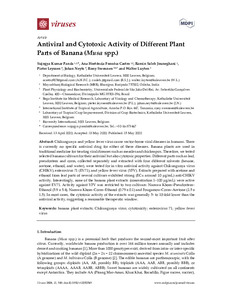| dc.contributor.author | Panda, S.K. |
| dc.contributor.author | Castro, A.H.F. |
| dc.contributor.author | Jouneghani, R.S. |
| dc.contributor.author | Leyssen, P., |
| dc.contributor.author | Neyts, J. |
| dc.contributor.author | Swennen, R. |
| dc.contributor.author | Luyten, W. |
| dc.date.accessioned | 2022-08-15T09:26:08Z |
| dc.date.available | 2022-08-15T09:26:08Z |
| dc.date.issued | 2020-05-15 |
| dc.identifier.citation | Panda, S.K., Castro, A.H.F., Jouneghani, R.S., Leyssen, P., Neyts, J., Swennen, R. & Luyten, W. (2020). Antiviral and cytotoxic activity of different plant parts of banana (Musa spp.). Viruses, 12(5): 549, 1-17. |
| dc.identifier.issn | 1999-4915 |
| dc.identifier.uri | https://hdl.handle.net/20.500.12478/7639 |
| dc.description.abstract | Chikungunya and yellow fever virus cause vector-borne viral diseases in humans. There is currently no specific antiviral drug for either of these diseases. Banana plants are used in traditional medicine for treating viral diseases such as measles and chickenpox. Therefore, we tested selected banana cultivars for their antiviral but also cytotoxic properties. Different parts such as leaf, pseudostem and corm, collected separately and extracted with four different solvents (hexane, acetone, ethanol, and water), were tested for in vitro antiviral activity against Chikungunya virus (CHIKV), enterovirus 71 (EV71), and yellow fever virus (YFV). Extracts prepared with acetone and ethanol from leaf parts of several cultivars exhibited strong (EC50 around 10 μg/mL) anti-CHIKV activity. Interestingly, none of the banana plant extracts (concentration 1–100 µg/mL) were active against EV71. Activity against YFV was restricted to two cultivars: Namwa Khom–Pseudostem–Ethanol (5.9 ± 5.4), Namwa Khom–Corm–Ethanol (0.79 ± 0.1) and Fougamou–Corm–Acetone (2.5 ± 1.5). In most cases, the cytotoxic activity of the extracts was generally 5- to 10-fold lower than the antiviral activity, suggesting a reasonable therapeutic window. |
| dc.description.sponsorship | National Council for Scientific and Technological Development |
| dc.format.extent | 1-17 |
| dc.language.iso | en |
| dc.subject | Bananas |
| dc.subject | Chikungunya Virus |
| dc.subject | Cytotoxicity |
| dc.subject | Enterovirus |
| dc.subject | Plant Diseases |
| dc.title | Antiviral and cytotoxic activity of different plant parts of banana (Musa spp.) |
| dc.type | Journal Article |
| cg.contributor.crp | Agriculture for Nutrition and Health |
| cg.contributor.crp | Roots, Tubers and Bananas |
| cg.contributor.affiliation | Katholieke Universiteit, Leuven |
| cg.contributor.affiliation | Mayurbhanj Biological Research, India |
| cg.contributor.affiliation | International Institute of Tropical Agriculture |
| cg.coverage.region | ACP |
| cg.coverage.region | Europe |
| cg.coverage.country | Belgium |
| cg.coverage.hub | Eastern Africa Hub |
| cg.researchtheme | Biotech and Plant Breeding |
| cg.identifier.bibtexciteid | PANDA:2020 |
| cg.isijournal | ISI Journal |
| cg.authorship.types | CGIAR and developing country institute |
| cg.iitasubject | Agronomy |
| cg.iitasubject | Banana |
| cg.iitasubject | Disease Control |
| cg.iitasubject | Plant Breeding |
| cg.iitasubject | Plant Diseases |
| cg.iitasubject | Plant Production |
| cg.journal | Viruses |
| cg.notes | Published online: 15 May 2020 |
| cg.accessibilitystatus | Open Access |
| cg.reviewstatus | Peer Review |
| cg.usagerightslicense | Creative Commons Attribution 4.0 (CC BY 0.0) |
| cg.targetaudience | Scientists |
| cg.identifier.doi | https://dx.doi.org/10.3390/v12050549 |
| cg.iitaauthor.identifier | Rony Swennen: 0000-0002-5258-9043 |
| cg.futureupdate.required | No |
| cg.identifier.issue | 5 |
| cg.identifier.volume | 12 |

